
I always dreamed of being featured on Forbes.
In my mind, it was one of the most elite online publications where only the best entrepreneurs get to share their advice with the world.
It was something I aspired to, but for a long time felt out of reach.
Until last week, when it finally happened.
Last week, an article with my advice got published on Forbes:
5 Secrets to Finding The Perfect Mentor
I opened my inbox and saw this e-mail pop up:

I rushed to click the link and binge-read through the whole article:

And I loved it.
As I was so excited about it, I emailed it out to my readers:
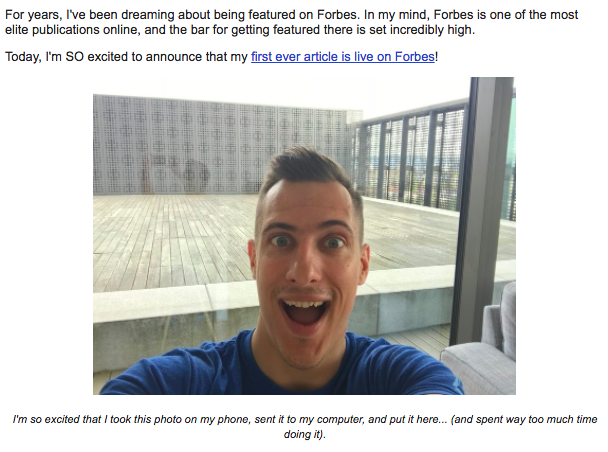
And at the end of the email, I asked my readers if they’d like me to write about how the opportunity happened:
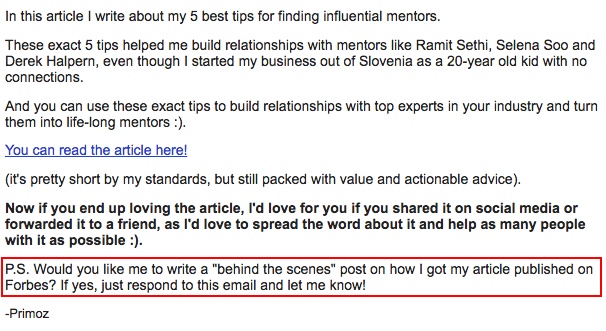
When I checked my email the following morning, I woke up to a flood of emphatic YESes:
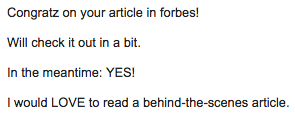
So I was left with no choice but to write the full “behind the scenes” of how I got featured in Forbes!
In this article, I’ll talk about how it all happened, from start to finish. I’ll talk about what exactly I did to land an article with Forbes, what my thought process was like, and what I’ll do differently next time.
Without further ado…
Let’s dive in!
STEP #1: Build relationships before you need them
I’ll be honest with you.
Before landing the opportunity to be featured in Forbes, I spent YEARS building authentic relationships with other entrepreneurs in my industry.
I did that without any expectations of getting anything in return, and I surely didn’t expect one of those relationships to bring me a Forbes opportunity.
But in my case, that’s exactly what happened (more on that soon).
It’s not a lone case either.
My features in Business Insider, Entrepreneur.com and Entrepreneur on Fire all came through building relationships.
Now if you’re thinking “that’s great for you Primoz because you had those relationships…”
STOP.
A few years ago, I was a 20-year old from Slovenia with no connections, and I had no-one to talk to about my business, PLUS I was an introverted, shy and socially awkward guy.
If you think about it, I had no business building relationships with the top experts in my industry.
And yet… I did it.
It took a lot of time and hard work, but I did it.
And you can do it too.
So if you’re at the stage where you’re dreaming of getting big opportunities for your business but have zero relationships built, that’s something you’ll want to start doing as soon as possible.
The good news is that I documented my whole process of building relationships with influencers in my industry, and published it on my blog so you can use it too.
You can find it in the guide below:
The Quick Guide to Surrounding Yourself With Successful People
Having the right relationships makes getting amazing podcast, guest post and media opportunities 1000x easier, and in my opinion, that’s the best place to start.
Note that I’m not sharing this with you because I’d want to discourage you or make you feel like an opportunity like this is “far out of reach”. It’s because I want to show you the REAL behind the scenes, rather than making things look easier than they are.
Ok, now let’s move on the first real step of my journey of being featured in Forbes:
STEP #2: The introduction
This whole journey started out with a very simple e-mail I got from a friend of mine:
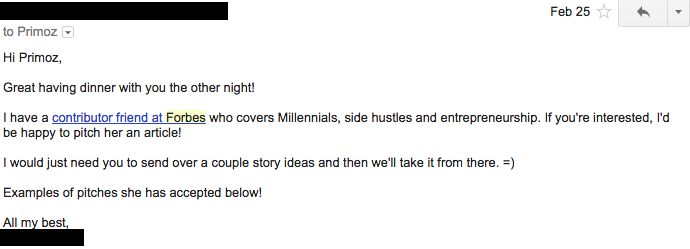
The behind-the-scenes context:
A friend of mine connected with an editor at Forbes who focuses on covering millennials and entrepreneurs.
As she has a lot of friends who fit that description, she reached out to 15 of her close friends and asked them if they’d be interested in being featured in Forbes.
As you can probably guess, I was one of her friends :).
And of course, I said YES!!!
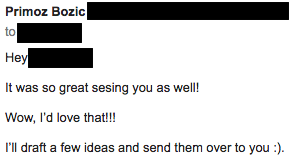
If you’re thinking “I could never get an introduction like this, so does that mean I’ll never be on Forbes?”, slow down.
As mentioned above, this opportunity came out of building relationships (which you CAN get started with doing today).
There are also other avenues which you could use to get opportunities like this (through online publicity courses where members get exclusive opportunities, through meeting writers in person at events, or through cold-pitching), though those are beyond the scope of this post.
And regardless of whether you can get an opportunity to write for Forbes or not… The principles and the process I talk about in this post can be applied to pitching any publication out there :).
STEP #3: Take fast action
I have a confession to make.
In the past, when I received big opportunities like this, I had a tendency to freeze.
I’d start doubting myself, feeling like I’m not good enough and becoming more and more paralyzed.
Because of this, I procrastinated moving forward. I avoided the opportunity.
As a result, it became harder and harder to take advantage of it (because you don’t want to follow up 2 weeks after you get the opportunity).
I hate to admit it, but quite a few opportunities slipped through my fingers because of this.
But a few weeks ago, something in me changed, and I decided to never let an opportunity slip out of my hands again – and I haven’t since.
Instead, I started to seize the opportunities right away.
In this case, that meant putting all non-urgent work off my plate and immediately diving into the research phase of the pitch the next day.
STEP #4: Do your homework
The last thing you want to do with an amazing opportunity like this is half-ass it. Sure, you want to act FAST, but that should never be an excuse for being lazy and skipping the necessary legwork.
The first thing I did as I started working on my pitch was to do some basic research on the writer.
Here’s what that looked like:
I googled the writer
Damn, this sounds like stalking already :D. But for the purposes of this article, let’s just call it “doing your homework”, ok?
So yeah, whenever you want to pitch someone, the first thing you should probably do is Google them.
Whenever I’m googling someone, I’m usually looking for their website, interesting articles they wrote, interesting articles that were written about them, their interviews… Etc.
In this case, I noticed she wrote for a handful of different websites and browsed through a few of her posts to get a feel for what she writes about:
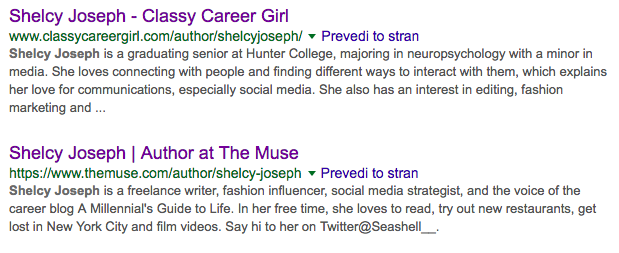
I checked out her Forbes contributor profile
After that I checked out her Forbes contributor profile, and read her bio box:
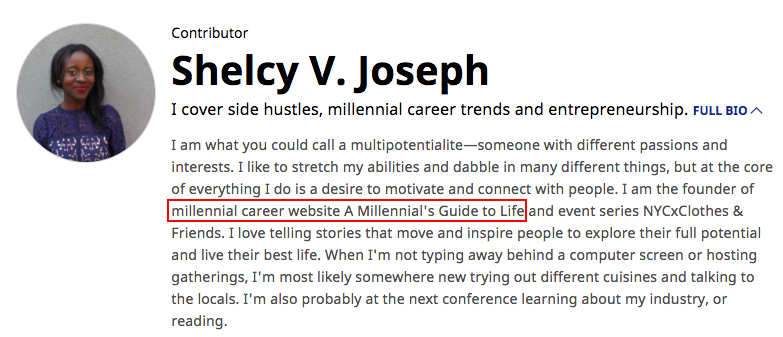
I noticed that she has a website called A Millennial’s Guide to Life, so I went on to check out her website and read some of her recent posts.
A post that caught my attention was “How I got an article published in Forbes”, so I read through the whole post and took notes on what I liked about it.
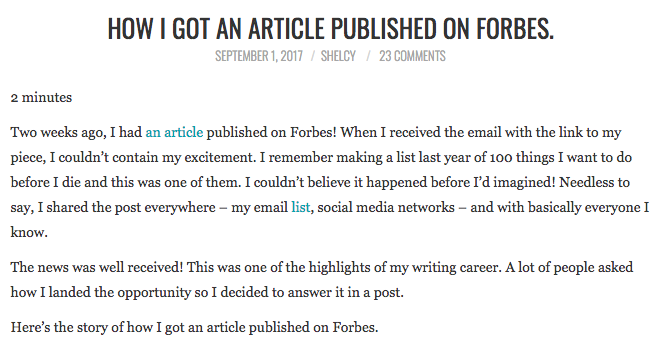
I looked through her recent blog posts
After checking out her website I went back to her Forbes profile and looked at some of her recent articles:
INSERT PHOTOS
As I did that, I noticed that all of her articles seemed to include a few tips about a specific topic (like “5 Simple And Fun Ways You Can Make Extra Money This Fall”), or a few steps to achieve a specific result (like “You Can Create a 6-Figure Business With These 8 Simple Steps”).
I also noticed that most of the articles followed a similar structure.
Here’s an example from “How to get over your fear of self-promotion”.
They began with a personal story:

Then they introduced the expert:

And finally, they included the specific tips from the expert:
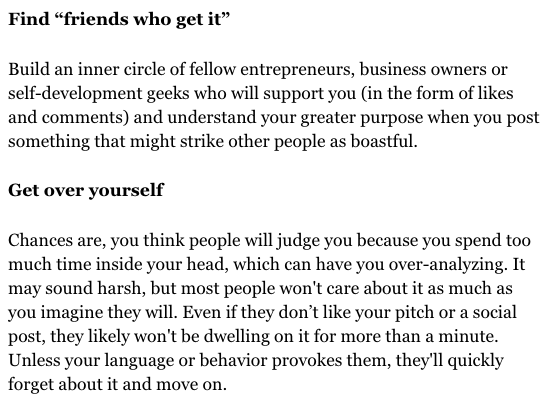
The “tips” were usually 1-2 paragraphs long, so I knew I could follow a similar framework in my own article when I wrote it.
I also looked at the topics of the blog posts to get a feel for what she usually wrote about:
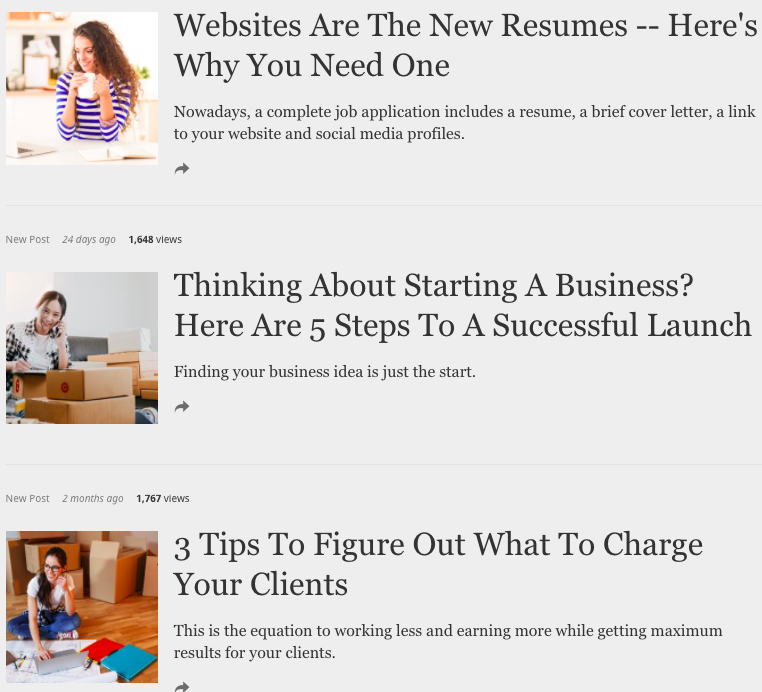
I noticed that a lot of advice was targeted at entrepreneurs (and a lot of them included X tips / steps), which helped me come up with my own ideas for the article that her audience would love.
I looked through her most popular blog posts
As the final (but DEFINITELY not the least important) step of my research, I took a look at some of her most popular posts from the “Popular posts” section:
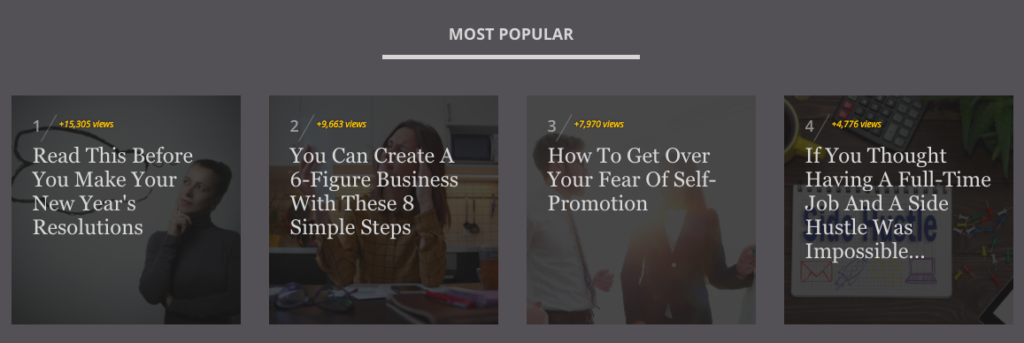
This helped me get a feel for what kind of content tends to take off on Forbes, so I tried to tailor my article ideas and writing to have the biggest chances of making the article a success.
While going through this process did take quite some time, I don’t think you can ever afford to skip this part of the process.
Not only will doing your homework increase your chances of getting your pitch accepted, it will also increase the chances of your article getting a lot of traction.
One thing I didn’t do… But should have
I’ll admit that I made one mistake with doing my homework for this opportunity because I wanted to make sure I take advantage of the opportunity while it’s still there.
I shouldn’t have just looked at the writer’s most popular posts, I should have also looked at the most popular posts within the #lifehacks section on Forbes, where she usually publishes her work:
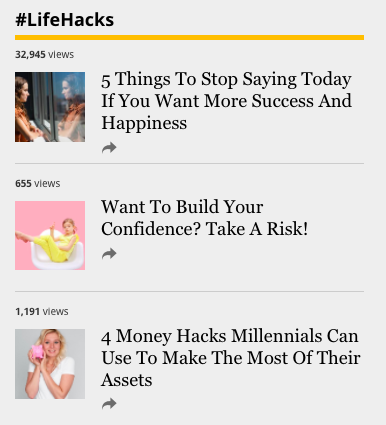
This might have helped me come up with even better content / structure ideas that I could then work into my pitch and article (as I’d be learning from the absolute best examples)
STEP #5: The Pitch
Once the homework is done, the fun begins!
I took some time to write a super detailed pitch, which I’ll share below (it’s a LITTLE bit on the long side, but I’ll explain).
In hindsight, this pitch could have been a bit shorter and to the point, and in the future I’ll try to make my pitches more concise. Still, since the pitch got accepted I must have done something right :).
Here’s the pitch break-down:
The introduction:

First, I pre-wrote a brief introduction that my friend could use to introduce me to the editor. I tried to use her voice and make her life as easy as possible.
The key thing here is that I kept it focused and brief, and I also included a link to my website through my name (this is a small detail that many people miss, but editors will really appreciate it as you save them some Googling time).
The media bio:
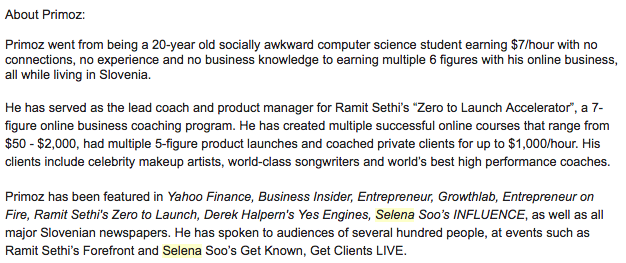
Next, I included my media bio with my past media appearances, which gave me some extra credibility and showed that I was an established expert already.
In the media bio, I talk about a few things:
- I start with a story that makes the writer interested in me
- I mention the kind of business I run and who my clients are so the writer can understand my business (or know how to present me to her readers)
- I talk about things like working with Ramit Sethi and having 5-figure product launches to establish extra credibility
- I also list all the past media coverage I’ve had, to show that I’m an established expert
NOTE: If you’re reading this and you’re thinking “I don’t have any / as much media attention as you yet…”, there’re two things I’d like to mention:
First, when I got featured on websites like Business Insider and Entrepreneur, I didn’t really have a “media bio”. I didn’t even know those existed, and I was never in the media before. My pitch was literally “I went from earning $7/h to $400/h out of Slovenia”. So to land big media, you don’t necessarily NEED a ton of previous media coverage.
Second, you don’t have to START at a publication like Forbes. You can take a lot of insights from this post to pitch smaller websites first, build up your credibility, improve your media bio and THEN pitch a bigger website like Forbes.
So don’t let not having a media bio (yet) hold you back!
Relevant links:
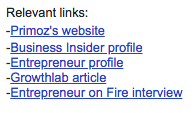
When a writer at a publication receives a pitch, the first thing they’ll do is google you.
The googling can sometimes be quite a time consuming process, so I decided to include relevant links to some of my past work / features just to save them some time.
It’s small details like this that make you stand out from the sea of other pitches, and make the writers really love working with you.
Building rapport:

I inserted a quick line sharing what I enjoyed from the article that I loved on her website to build rapport and show that I’ve done my homework.
I could have shared more details here, but as the pitch was already becoming pretty long I decided to make this section shorter.
The article ideas:
Ok, now we’re getting to the MEAT of the pitch:
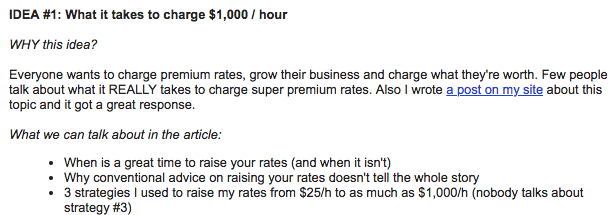
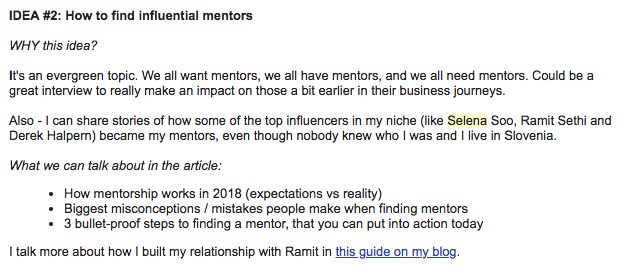
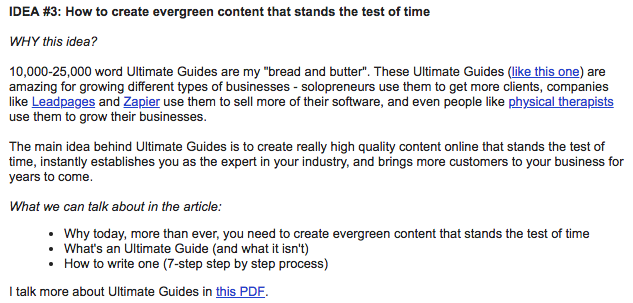
If you pay close attention to my article ideas, you’ll notice that I broke down each one of them into 3 steps:
- WHY this is a good fit for Forbes
- WHAT I would write about in the article
The first part is there to show the writer why they should consider the idea, and the second part (the bullets) gives them an idea for what to write about and helps them visualize the finished article.
As you look over the ideas, notice a large number of links that are scattered throughout them. This is again intentional as I’m giving the writer extra resources that they can reference if they need them.
Again, almost nobody does this and it’s a great way to stand out.
You’ll also notice that the bullets are short, sweet and easy to skim – rather than long walls of texts people sometimes tend to write
Looking back, I definitely could have made the “WHY” section more compelling. I could have taken the extra steps to research similar articles on Forbes and made a stronger case why these topics would be a great fit for Forbes (whereas I focused the “WHY” section mostly on myself).
I believe that the ideas #2 were a good fit for Forbes, while the third idea might be too niche uninteresting to the Forbes audience in its current form.
I also could have tailored the bullets a bit better to the article format (for example, with idea #2 that ended up being accepted, I could have simply made the bullets about the “tips” rather than my ideas.
The wrap up:

In the final few lines of the email, I do a couple of things.
I start with the call to action and specify exact next steps (rather than just saying “what do you think?”).
I also mention that we could do a profile-based story that could become a big hit on Forbes, in case she’d be interested in that.
And in terms of the pitch… That’s it!
STEP #6: The waiting game
I heard back from the Forbes writer on April 12th (a month and a half after I sent out the pitch, on February 26th).
This is quite a long time, and in the meanwhile, I didn’t really think about the pitch. I see a lot of people really slow down after they receive a big opportunity and stop pushing themselves after they do.
I’ve done the same thing myself in the past, but then when I saw how long articles like these take to get published, I stopped worrying about things I can’t control and just focused on my work.
And over the past few months, as I worked on putting myself more and more, I learned how to use opportunities like this to actually build momentum and chase more and more opportunities (it becomes an addiction!).
STEP #7: Writing the article
As soon as I saw that my article idea was accepted, I got to work.
The next morning I put together a rough draft for the pitch.
You can read the FULL rough draft here.
It’s too long to fit on this page ;).
After I wrote the first draft, rather than sending it to the editor right away, I ran it by a few of my friends:
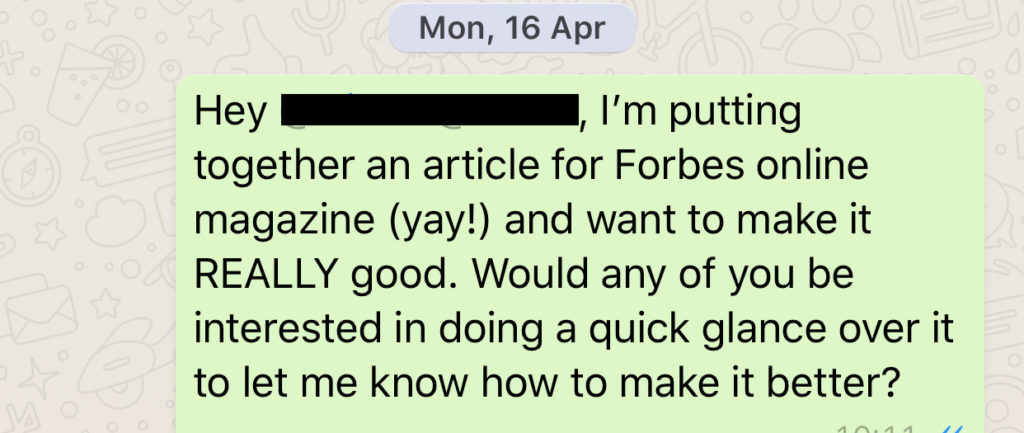
I asked my friends for feedback on my article because I didn’t have a lot of experience with writing short articles like this, and because I wanted to make the article REALLY good.
The first iteration of the article was really long, and I almost wrote it as the whole article (as I was told to “write some tips in a Google document”, which I didn’t 100% understand).
I got a lot of great feedback from my friends that helped me improve my writing voice and make my advice more pointed and actionable.
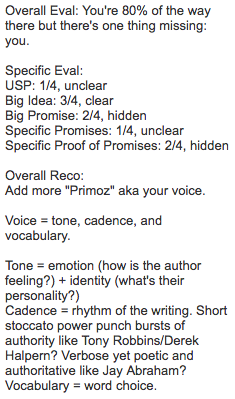
I also received an example of the “tips in a Google document” example which helped me understand exactly what the writer was looking for (I can’t share that one publicly, unfortunately, as it’s part of an online course).
By using all the feedback and getting a great example of what the writer is expecting, I went on to finish and submit a much tighter version of my article (though I still made sure it was super actionable and valuable):
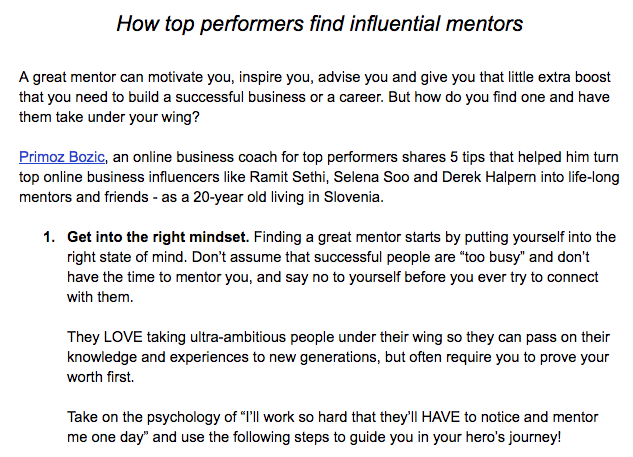
The final version of the article I submitted to Forbes.
Notice how I try to go above and beyond for the writer by giving her extra examples to use in the article (in case she doesn’t like some of them) and by giving links to extra relevant blog posts:
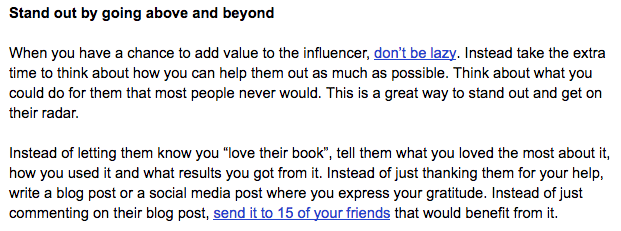
I wanted to include specific examples of people in the post to make the article more relatable and useful, and I also wanted to get more exposure for the amazing work of people I know.
While most of the links didn’t get included in the end, some of the examples did, which I was really happy about.
In terms of the pitch, that was more or less it. I sent out the article tips on April 17th and hoped for the best:

STEP #8: Spreading the word
On April 24th, exactly a week after I sent the tips to the writer, the Forbes article with my tips went live!

Because I really wanted this article to be a success for the writer, I immediately found a few ways to spread the word about it.
I shared it on my own Facebook wall:
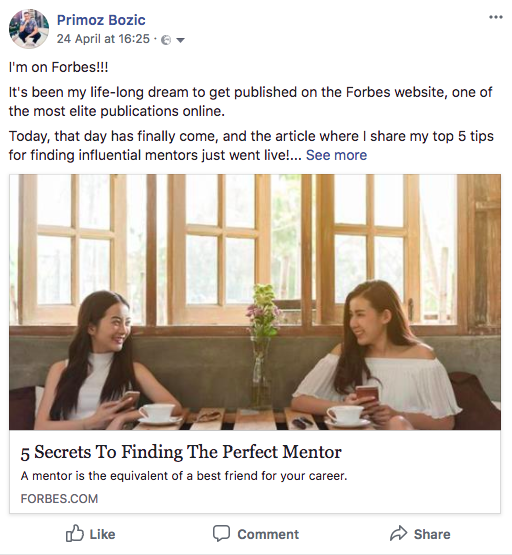
I sent out an email to my readers about it:

And I also shared it in a few Facebook groups where I thought the readers might benefit from it:
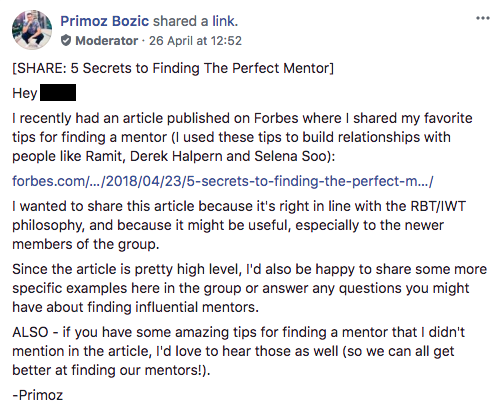
As I shared the post I made sure I only shared it in groups where I thought the members could genuinely benefit from it, and I also always offered to answer any additional questions about the article to add even more value to the community members.
In the future, I’ll spend more time mentioning this article and sharing it wherever I find it relevant, as I do feel like it’s a good piece of content that could genuinely help people.
STEP #9: Thanking the writer
I was really excited that my article got featured on Forbes and love the way in which the writer wrote it, so I sent a quick thank you e-mail to them:
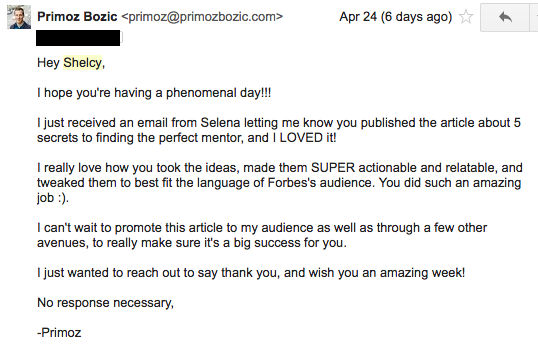
I like doing this whenever someone helps me out to build a relationship with them and express my gratitude, and sometimes I’d also send a gift to them.
It’s a small touch that makes you stand out from everyone else and makes people want to work with you more in the future.
STEP #10: What I’d do differently next time
After every article I get published in the media, I reflect on what I can do better next time.
As I looked at the stats on the article, I saw that it got around 3,700 views within a week of publishing:
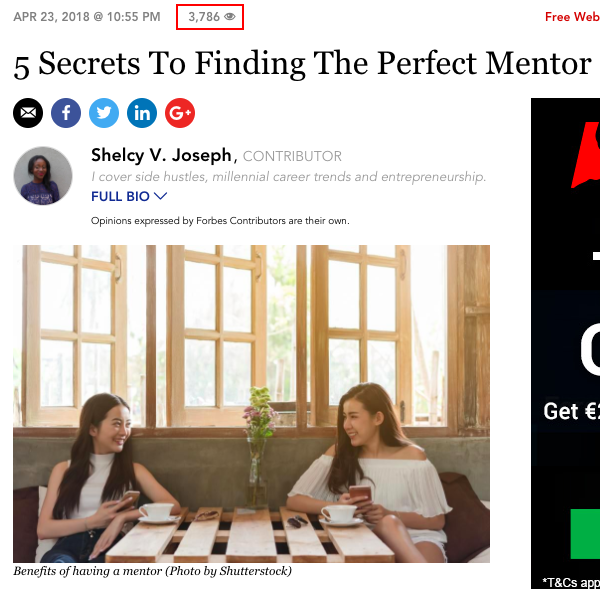
This isn’t bad (plenty of articles get less than 1,000 views), especially for my first shot at writing for a publication like this, and I know that the article will slowly get more traction over time.
Still, I feel like there are a lot of things I could have done better throughout my process so I can write a better pitch and a better article next time.
To write an article that gets 10,000 or 100,000 views (and really bring my name out to a lot of new people), the biggest thing I’ll need to get better at is coming up with great article ideas.
Especially on websites like this, people click on (and share) interesting STORIES. That’s how my Business Insider article got over 111,000 views:
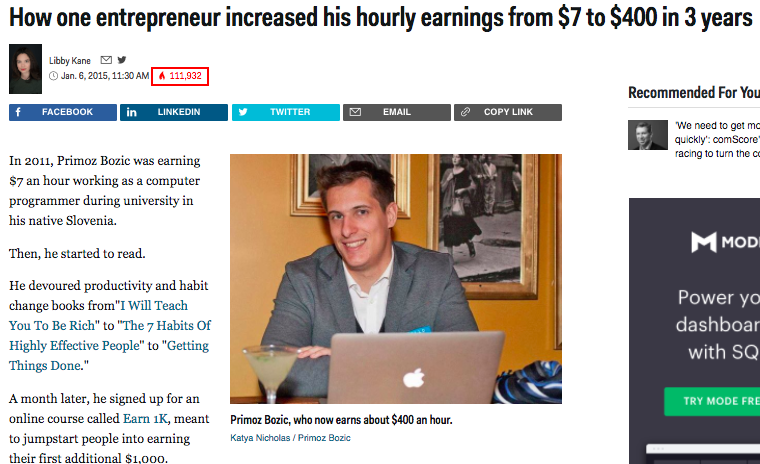
I definitely need to get better at finding relevant stories that I can work into my articles that are relevant to more people, and that’s the #1 thing I’ll be working on in the future.
I’m also going to improve my process based on the lessons I got from this experience.
Now I know how to write article tips to send to a writer, I’m getting a feel for what they find important and what they skip on, and over time I know I’ll be able to create better articles and pitches to further grow my online business.
BONUS: My pitch-checklist
I’m a big fan of creating processes and checklists, so naturally, I wanted to break down my process into a step-by-step process you can follow to get featured in publications like Forbes.
Here are the exact steps that you can use to get there:
- STEP #1: Build relationships before you need them – Use my Quick Guide to Surrounding Yourself With Successful People to get started!
- STEP #2: Take fast action when an opportunity comes – Don’t wait (or let yourself procrastinate). When an opportunity comes, face your fear and act on it immediately!
- STEP #3: Do your homework – Always google the writer you’re pitching, their past work, their most popular work, and the most popular articles on their platform. Pay close attention to how they structure their articles and the topics they write about.
- STEP #4: Write an amazing pitch – In the pitch, make sure you share your story, what you do, include any past media coverage, and share 1-3 ideas with bullet points explaining each idea. Make the editor’s life easier by including all the relevant links.
- STEP #5: Don’t wait… Move on! – Once you submit the pitch, don’t wait to hear back as that might take weeks or months. Instead, occupy your mind with chasing the next opportunity on your plate!
- STEP #6: Get help with your writing – When you have an opportunity to write for a really big publication, don’t hesitate to reach out to your friends and ask them to help you write the best possible article. They’ll love helping you out!
- STEP #7: Spread the word – Don’t just wait for the article to take off on it’s own once it’s live. Find a way to spread the word about it through your social media, your e-mail newsletter and any relevant places (like Facebook groups) where your article could really help people.
- STEP #8: Thank the writer – Every time you get featured in the media, send a thank you note to the writer. They’ll appreciate it and want to work with you more in the future!
Well, that’s it for today!
I hope you’ve enjoyed reading this article as much as I enjoyed writing it.
What’s your #1 takeaway from this article?
Let me know in the comments below!
Learn how I attracted 337,838+ visitors to my blog

Download my free 13,000+ word Ultimate Guide Checklist and learn how I used Ultimate Guides to drive 337,838+ visitors to my blog!
Hey Primoz,
Thanks for this insightful article jam-packed with valuable information. I have a tendency to skim through articles that have actionable steps that are highlighted, but I devoured your stuff here today. Thanks for your wisdom, will put it to good use!
So glad you enjoyed it!
Thank you Primoz for this detailed write up. Such a great read. I’m going to read it again!!
You’re welcome! 🙂